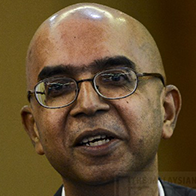In my previous column, I said what HIS/BA (Household Income and Basic Amenities Survey 2012) considers income includes “notional income”. I said the HIS/BA report stresses average income although the median income is more meaningful. I said the report underplays the extent of inequality in our nation.
In this column, I will provide more information about HIS/BA and express 5 things I hope for in the 11th Malaysia Plan.
HIS/BA is based on a “representative” sample of households: prior information about the overall population is used to select a sample of households which will represent all Malaysian households.
The principal strata in the HIS/BA is urbanisation (urban/rural). Other dimensions include ethnicity and region (states/Federal Territories).
The sample of 44,106 households was selected using “stratified sampling”, a well-established practice.
The number of households is dictated by what statisticians call “acceptable error” and by what funders call cost.
Strangely, the HIS/BA report does not tell us what “acceptable error” the statisticians used in order to determine the sample size.
The actual sample included 30,848 households in the peninsula and 13,258 households in East Malaysia and Labuan. Region-wise, the range of households in the sample lies between 326 (Putrajaya) and 4,681 (Selangor).
Sampling error is very important in surveys. In HIS/BA, the sampling error indicates the uncertainty introduced by a decision to draw conclusions about 7 million households by reviewing 44,000 households.
The HIS/BA report measured the sampling error using the Relative Standard Error (RSE).
The RSE computed to 0.6% and was used to estimate Confidence Intervals.
Consistent with the underplaying of median incomes, the HIS/BA report does not provide a confidence interval for the median household income, which is RM3,626 per month.
The HIS/BA report says the 95% confidence interval for the mean monthly household income is RM4,943-RM5,057.
This means that if thousands of similar surveys had been conducted during the same period, 95% of the surveys would have reported a mean (average) household income in the range of RM4.9-RM5.1K per month.
That sounds impressive – until we recall that the average is often not useful. For instance, the average of 1, 3, 4 and 20 is 7 and that is hardly useful, whereas the median (“middle number”) informs us half the numbers are less than 3.5.
Nevertheless, it’s worth noting that the confidence interval is different for each ethnic group. Bumiputera: 4.4-4.5 KRM; Chinese: 6.2-6.5 KRM; Indians: 4.9-5.5 KRM; “others”: 3.2-4.5 KRM.
Note: The RSE is 8.7 for “others”, which includes Eurasians. “Others” no longer includes Malaysians of Punjabi and Sri Lankan origin.
It is remarkable that despite the introduction of the NEP 44 years ago, there is no overlap in the confidence intervals except between Indians and “overall”: The range for Indians (4.9–5.5 KRM) “overlaps” the range for the overall average (4.9–5.1 KRM).
I imagine if the data for Malays were separated from the data for “other Bumiputra” (including Orang Asli and the natives of Sabah and Sarawak) – as in national census data – there would be more overlap between groups.
I hope (1) the 11MP will break out the data for Malays.
It is possible to calculate confidence intervals for the median as well.
I hope (2) the 11MP will calculate and publish confidence intervals for the medians.
The median household income for the four “ethnic” groups is: Bumiputera: RM3,282; Chinese: RM4,643; Indians: RM3,676 and “others”: RM2,762.
The median is important for assessing poverty. Eliminating poverty has been a stated goal of every national development plan and will be one of the goals of the 11MP.
I hope (3) the 11MP will drop the “absolute” necessities-based poverty line income of RM830 used in the HIS/BA report.
The Malaysia 2013 Human Development Report (MHDR) recommends using a relative poverty measure. It recommends drawing the poverty line at half the median income.
The poverty line would then be RM1,813, and 20% of Malaysian households would be classified as poor – the same percentage as in 1989, so for the 11MP to adopt this line will require immense political will.
I hope (4) the 11MP will adopt a relative poverty measure.
To reduce the problem of poverty, MHDR recommends imposing a higher minimum wage. Another important solution is to close the gap in wages across gender – according to Jomo and Wee, men’s wages are nearly twice as high as women’s wages (Malaysia@50, SIRD: 2014, page 95).
Action on wages also requires political will, as both wages and inflation will increase. I note that the Selangor government has increased the minimum wage for its employees to RM1,500 per month.
I hope (5) the 11MP will increase the minimum wage.
What do you hope for in the 11MP? – April 16, 2015.
* This is the personal opinion of the writer or publication and does not necessarily represent the views of The Malaysian Insider.


Comments
Please refrain from nicknames or comments of a racist, sexist, personal, vulgar or derogatory nature, or you may risk being blocked from commenting in our website. We encourage commenters to use their real names as their username. As comments are moderated, they may not appear immediately or even on the same day you posted them. We also reserve the right to delete off-topic comments